Some North Bay winemakers are starting small and keeping the dream alive.
With a nurturing touch, an enviable palate and a passion to deliver the best possible wines, small, independent winemakers across the North Bay (and beyond) have dedicated an innumerable amount of time, love and labor, to their vintners’ visions. For this story, NorthBay biz contacted a handful of very small (often less than a few hundred cases per varietal), truly independent (no family connection to the industry or large fallback fund) winemakers who are chasing their dreams, one vintage at a time.
Many have worked their way through the ranks, often winemaking for other wineries while nurturing a drive to produce their own wine under their own label. And while some have “made it,” in terms of producing enough to fund themselves and quit their day jobs, others are still working toward their dream. But while being a small wine producer has its challenges—funding being the most obvious one—there are many unique attributes that benefit both these artisans and their customers.
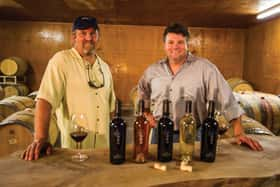 “We believe small, independent winemakers are the true artisans in this industry; the innovators and craftspeople,” says winemaker Steven Gower of Crux Winery, who, along with co-owner Brian Callahan, crafts small lots of Rhone varietals—Grenache, Petite Sirah, Syrah, Mourvedre and Viognier—as well as Zinfandel and Sauvignon Blanc from Sonoma County’s Russian River Valley. “We’re able to explore lesser-known varietals and winemaking styles without the pressure to fit a certain market niche. To produce wines in such small quantities, every step is hands-on. Each cluster, each barrel and each bottle is tended.”
“We believe small, independent winemakers are the true artisans in this industry; the innovators and craftspeople,” says winemaker Steven Gower of Crux Winery, who, along with co-owner Brian Callahan, crafts small lots of Rhone varietals—Grenache, Petite Sirah, Syrah, Mourvedre and Viognier—as well as Zinfandel and Sauvignon Blanc from Sonoma County’s Russian River Valley. “We’re able to explore lesser-known varietals and winemaking styles without the pressure to fit a certain market niche. To produce wines in such small quantities, every step is hands-on. Each cluster, each barrel and each bottle is tended.”Because these small-scale wine producers are only making one or a few barrels at a time, usually by themselves, there’s much less risk involved in trying an innovative technique than if it were attempted on a large scale with the added responsibility of employees’ livelihoods at stake. Therefore, it’s often these independent winemakers who produce the most unique and distinctive wines.
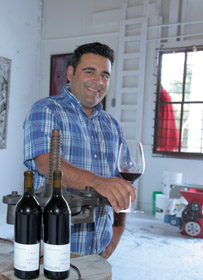
“When you’re operating on a small scale, you can make the decisions,” says P.W. Scoggins of PW Scoggins Winery, who started producing Zinfandel and Pinot Noir in 2012 with grapes from Russian River Valley and Healdsburg. “I think a lot of people make compromises because they have more on the line. I have less on the line, so it frees me up to take the risk I want to take.”
A helping hand
Even though the small, independent winemakers can often feel like a David against Goliath wineries, more often, the attitude and environment is one of mentorship, not competition. Instead of worrying about more players in the game, wineries that have already established themselves have been known to reach out to their up-and-coming peers and offer support, assistance and advice.
 “[Supporting each other] comes very natural to us, because winemakers are really farmers at heart,” says Sarah Francis, vigneron and producer of Sarah Francis Wines, which produces 150 cases of Cabernet Sauvignon and Chardonnay from Napa Valley grapes. “The majority are little people like me, and that’s how the valley started. It was a small farming community that slowly turned into a viticulture community. Farmers still operate on handshake contracts, and the majority of things we do is by looking at someone face-to-face and saying, ‘You can trust me.’ That’s how we get along. There’s a very big spirit of innovation here. There’s an attitude of ‘there’s plenty,’ and you look at the world here from the vantage point of abundance, not of scarcity. Everyone has their niche.”
“[Supporting each other] comes very natural to us, because winemakers are really farmers at heart,” says Sarah Francis, vigneron and producer of Sarah Francis Wines, which produces 150 cases of Cabernet Sauvignon and Chardonnay from Napa Valley grapes. “The majority are little people like me, and that’s how the valley started. It was a small farming community that slowly turned into a viticulture community. Farmers still operate on handshake contracts, and the majority of things we do is by looking at someone face-to-face and saying, ‘You can trust me.’ That’s how we get along. There’s a very big spirit of innovation here. There’s an attitude of ‘there’s plenty,’ and you look at the world here from the vantage point of abundance, not of scarcity. Everyone has their niche.”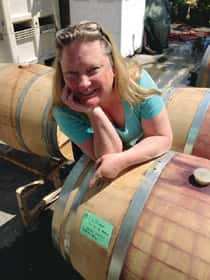 Stephanie Trotter-Zacharia of Trotter 1/16 Wines, which produces Napa Valley Cabernet Sauvignon, agrees and claims winemakers are producing “liquid art.” As artists, she explains, winemakers respect each other’s creativity and are willing to help each other, realizing that no two wines are the same.
Stephanie Trotter-Zacharia of Trotter 1/16 Wines, which produces Napa Valley Cabernet Sauvignon, agrees and claims winemakers are producing “liquid art.” As artists, she explains, winemakers respect each other’s creativity and are willing to help each other, realizing that no two wines are the same.“Since I decided to make wine, there’s been a plethora of winemakers willing to help me,” she says. “People shared spreadsheets with me, licensing information, what they had to buy, what they did, shared their financial background with me.
“Even now, if I had a question about interpreting lab reports or an analysis on the wine, I have 10 winemakers in my cell phone I could call. The industry is so amicable, it’s not competitive at all.”
The business side of winemaking
That being said, being a small, independent winemaker isn’t without its challenges. As in most startup businesses, funding is always an issue, and when one considers the time it takes for wine to go from grape to glass (usually at least two years), the challenge is increased exponentially. Most winemakers starting from scratch need to self-fund or gain the support of friends and family.
“A big challenge in the beginning is paying off licensing fees and all the other fees associated with starting up a winery,” explains Scoggins. “There’s a lot of paperwork through the government and city council. It’s $1,000 here and $1,000 there, and you think, ‘Is this ever going to end?!’ I worked two jobs at wineries and used their equipment to get started, and every penny I’ve earned goes back into the grapes. I tried to get loans, but it’s nearly impossible. You have to show cash flow and a certain amount of inventory. What has been helpful is that a lot of friends and family have put in for futures of the wine.”
Scoggins isn’t the only one to sell futures to help fund his venture. Other creative techniques include taking on grapes that a grower doesn’t want or taking on investor business partners.
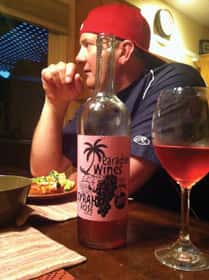 “The bartering system has worked for me so far,” explains winemaker Marty Paradise of Paradise Wines and Paradise Ports, who started in early 2007 bottling just a couple hundred bottles of Syrah rosé and now produces several barrels of ports, Petite Syrah, Cabernet Sauvignon (from Yountville), Syrah and Charbono (St. Helena). “I paid for my labels, but all other supplies—bottles, corks, foils and equipment—has been on a barter or trade. My biggest challenge has been finding grapes to pick for free or for trade. I usually just ask to pick three-quarters to one ton of grapes, enough for a barrel or two.”
“The bartering system has worked for me so far,” explains winemaker Marty Paradise of Paradise Wines and Paradise Ports, who started in early 2007 bottling just a couple hundred bottles of Syrah rosé and now produces several barrels of ports, Petite Syrah, Cabernet Sauvignon (from Yountville), Syrah and Charbono (St. Helena). “I paid for my labels, but all other supplies—bottles, corks, foils and equipment—has been on a barter or trade. My biggest challenge has been finding grapes to pick for free or for trade. I usually just ask to pick three-quarters to one ton of grapes, enough for a barrel or two.”Taking on what others didn’t want is how Trotter-Zacharia got started in the wine business. After 20 years working in the industry in many different capacities and for several different wineries in the Calistoga area, she wanted some autonomy and a chance to create her own label. This drive, coupled with an opportunity in a bad growing season, gave her the chance she needed.
“2011 was such a terrible growing season, and the winery I was working for, which had a little Cabernet vineyard—just 125 vines—had so much mold in the vineyards that year because of the rains,” explains Trotter-Zacharia. “They said I could pick it and try making wine with it.
“They knew I wanted to have a shot at making wine, all on my own, rather than just being an apprentice winemaker, which I’d been for about 12 years. So they let me pick it, they sponsored it and bought the barrels. My friends and I had to hand-sort every berry. When I left there, the next winery I worked with purchased the wine in bulk, bottled it under their license and sold the wine back to me after bottling.”
This inaugural release of the 2011 Napa Valley Cabernet Sauvignon has already been awarded a silver medal as a barrel sample submission and two more medals as a pre-release at the San Francisco Chronicle International Wine Competition and the Women’s International Wine Competition, just three months after bottling. What had started as a lot that would most likely have been thrown away turned into an award-winning wine under the guidance and nurturing of Trotter-Zacharia’s hand.
Getting the word out
Earning awards or high Wine Spectator scores certainly helps smaller winemakers get their product out into the marketplace, but being small definitely makes marketing more challenging.
 “Every business needs good marketing no matter how good their product is,” says Eric Buffington, winemaker and partner of Amelle Wines, which produces 250 cases per year of Sonoma Coast and Russian River Valley Pinot Noir and Russian River Valley Zinfandel. “Boutique wines are a tough market, and there’s a lot of good product out there.”
“Every business needs good marketing no matter how good their product is,” says Eric Buffington, winemaker and partner of Amelle Wines, which produces 250 cases per year of Sonoma Coast and Russian River Valley Pinot Noir and Russian River Valley Zinfandel. “Boutique wines are a tough market, and there’s a lot of good product out there.”For most small, independent winemakers, even finding a distributor can be a challenge, since many distributors don’t want to work with a winery that can only supply a limited amount and no marketing support. So for these small producers, word of mouth is key. And in cases where the winemaker doesn’t have a bonded winegrowers’ license, but rather one of the alternative licenses that only allows direct sales to consumers in California, word of mouth is practically the only option.
“The license I have is strictly a retail license,” explains Trotter-Zacharia. “So I have to make the wine in a custom crush situation. For sales, I’m not allowed to pour the wine for sampling in a public venue. I can only share it in my home or a private setting. So I bring it to dinner when I’m invited somewhere, and people taste it. If they like it, they can go to my website to order it.”
Social media has also proven invaluable to many smaller-scale wineries, getting the word out on new releases, awards won and upcoming events.
From grape to bottle
Many small wine producers truly need to be a “jack of all trades”—from farming and harvesting the grapes to making the wine and handling operations such as bottling, labeling and warehouse work, as well as marketing, sales and business administration.
After eight years working in almost every position in the wine industry, from cellar work to assistant winemaker, Scoggins felt the time was right to try his hand at producing wine. So when a farmer sold him a ton of grapes, PW Scoggins Wines was born; he ultimately purchased three more tons that same year.
“Originally, when I was making wine up in Healdsburg, I was buying grapes because I was making wine for other people,” explains Scoggins, who started leasing his own vineyard and winery space in Penngrove in spring 2014. “But now that I’ve been on my own, I try to farm all the wine I’m making.”
His pride in showing the vineyard, illustrating his dry farming technique and pointing out the intricacies of how the topography of the land affects the various grapes, is evident. The wine is literally tended from grape to bottle. It’s this level of detail and oversight of the whole process by hand that can set small, boutique wineries apart from the big players in the industry.
“There’s enough grand wineries out there,” says Scoggins. “I’m not going to be one of those—I can’t. I can’t outspend these huge wineries, but I can do all the work myself. To do all the farming, make all the wine, bottle and sell it…. I can do that.”
The future looks rosé
While big wineries will continue to dominate retail shelves and restaurant wine lists, many of the independent winemakers interviewed for this story believe that the future of the wine industry here in Napa and Sonoma counties is going to depend on the individual—the passionate artist and winemaker. Those producers who take the risks, drive innovation and raise the bar to new levels.
“The wine-loving public should seek out these types of producers and support the ones they enjoy,” suggests Crux Winery’s Callahan. “Like any consumer product, people should buy what they like. Wine as a product is fairly unique in that samples are available at no or low cost, so be adventurous.”
Now that’s advice one can drink to.
Keeping It Legal
Besides needing to possess three very different and unique skills—vineyard farming, winemaking and sales and marketing—independent winemakers also need to sludge through the often overwhelming paperwork required to meet compliance and achieve licensing with local authorities such as the city or county planning departments, the state of California’s Alcoholic Beverage Control Department (ABC) and, on the federal level, the Tax and Trade Bureau (TTB). Licensing and compliance can be so complex that many producers (big and small) hire compliance consultants to assist them in sorting out the process.
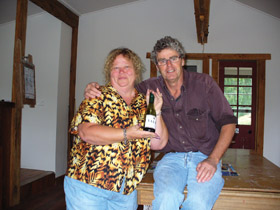 “When somebody comes to me with an idea, I get to help them make their dreams become a reality,” says Andrea Anderson, president of Beer and Wine Services, Inc., which has been helping individuals in the alcoholic beverage industry obtain licensing and compliance with federal and state regulations since 1989. “I help them take care of the paperwork, because the important part isn’t just getting the license but also dealing with paperwork after the fact. I’m there as a partner to follow up and follow through after the initial process. It’s what I’m good at, just like they’re good at making and selling wine.”
“When somebody comes to me with an idea, I get to help them make their dreams become a reality,” says Andrea Anderson, president of Beer and Wine Services, Inc., which has been helping individuals in the alcoholic beverage industry obtain licensing and compliance with federal and state regulations since 1989. “I help them take care of the paperwork, because the important part isn’t just getting the license but also dealing with paperwork after the fact. I’m there as a partner to follow up and follow through after the initial process. It’s what I’m good at, just like they’re good at making and selling wine.”According to Anderson, only the Type 02 license allows for the manufacture of wine (it’s also called a winegrowers license by the state or a bonded winery permit by the federal government). However, there are other options for businesses or individuals interested more in marketing wine or having wine custom crushed to their specifications (instead of actually producing the wine on a bonded wine premises).
“All the other licenses that are out there [other than Type 02] require you to contract with a winery to make the wine for you,” explains Anderson. “So you don’t really get to make it yourself. Rather, you get to instruct them on how to make it. For a lot of people, control is a big issue. Most people believe that doing it themselves guarantees quality control.”
That being said, alternative licenses to the Type 02 can be a good way for a small player to get started selling wine under his or her own label, albeit it in a very limited way.



